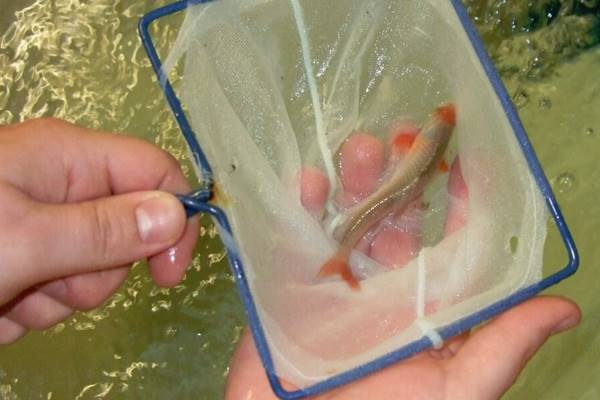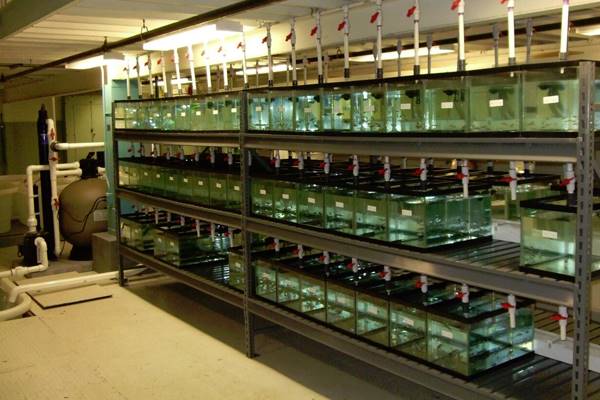Muddy Water Has Shiners Courting The Wrong Species, Study Finds
In a sad case of mistaken identity, a recent study found that a common native fish species was more likely to interact with an invasive species when they both swam in turbid water. The results suggest native species could be more likely to hybridize with invasive species in waters clouded by algae and sediment from runoff.
The study of shiners in the Coosa River Basin found that native blacktail shiners were more likely to socially interact with invasive red shiners when subjected to turbid water conditions. This is especially troubling because the system is also home to blue shiners, a species listed as threatened under the Endangered Species Act that is vulnerable to hybridizing with red shiners.
“It’s pretty clear-cut that we need to do things to reduce the amount of sediment load going into rivers and streams and lakes,” said Greg Glotzbecker, lead author of the study. “It is a very clear case that the impacts of turbidity are quite negative on aquatic biodiversity.”
For decades, scientists have been looking at the physical problems sediment causes for some fish, including scouring gills and smothering eggs. But this study is part of a growing body of new research that suggests sediment can also harms fishes in non-physical ways.

A red shiner netted from a laboratory tank. (Credit: Greg Glotzbecker)
In this case, the thought is that the clouded water interferes with the visual cues behind the shiners’ reproductive behaviors, which includes male courtship displays. Blacktail shiners — native across the Southeast — and red shiners — invasive from California to Georgia — are both group-spawning fish with males that defend small territories of rocks or sticks. “They spread their fins, they do these particular little dances, as we call them, in hopes that they can entice a female to come in and deposit eggs within the territory that he’s defending,” Glotzbecker said. Then the male fertilizes the eggs.
Those mating interactions are based on vision and responses to the color of the fish and their movements.
“In turbid water, less light mutes the visual signal,” he said. “So if a fish has a particular coloration, or a particular shape, or performs a swimming dance, we would expect some of those interactions could be altered.”
Researchers in Texas looking in waters prone to elevated turbidity had previously reported an especially high number of hybrids between blacktail and red shiners as early as the 1950s, which mix the deep body shape of the red shiner with the blacktail’s black spot on the tail base. Since those reports were only observational, Glotzbecker and his colleagues at Tulane University sought to back up the connection between turbidity and hybridization with a controlled lab experiment.
The researchers collected mature blacktail and red shiners from the wild during spawning season and brought them back to the lab, where Glotzbecker built a three-chambered experimental testing tank. They placed a female in the middle chamber and a male of either species in the two adjacent chambers, removing plastic dividers between the chambers after a few minutes had passed and the fish had acclimated.
A black curtain in front of the tank hid the researchers and a video camera, which recorded the number of times a female approached males of each species, the number of times a male interacted with a female, and for how long they interacted. After 40 trials that mixed males and females in all combinations of species as well as in clear and turbid water, it was up to Glotzbecker to review the videos and record the results.

The aquatics research facility at Tulane University holds fish for study. (Credit: Greg Glotzbecker)
“I spent many hours sitting in this dark room by myself with these fish,” said Glotzbecker, who also watched hours of video of the interactions. “It was interesting at times, but I’m not sorry that part’s over with.”
The results first showed that both species were more socially interactive in turbid water, which the researchers weren’t expecting. They also found that native blacktail shiner females interacted more with invasive red shiner males under turbid conditions. Additionally, red shiner males had increased their courting behavior across the board.
Two shiner species intermingling may not sound like much of a problem. But the observed increase in pre-mating interactions between these species suggests that elevated turbidity could make it more likely that invasive species will contaminate native gene pools after they invade habitats prone to sediment pollution.
When this happens, the worst case scenario would result in two species collapsing into one intermediate species, as the hybrids become more prevalent and the native species become increasingly rare, which could occur in as little as a decade. This would be especially troublesome in the Coosa River Basin if the observed laboratory interactions with blacktail shiners are also occurring with threatened blue shiners in the wild.
“Basically it could result in the extinction of a species, which is something that we don’t want to have happen,” Glotzbecker said. “How long that will take? It’s hard to say. But it’s definitely a road that we don’t want to go further down than we have to.”
Reducing the sediment loads going into rivers and lakes could help stop a trip down that road. Though that’s a widespread and complicated water quality issue, it turns out rivers are easier to clean than the gene pool.
The study is published in the scientific journal Freshwater Biology.



0 comments